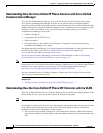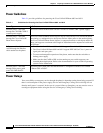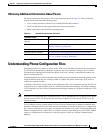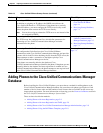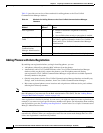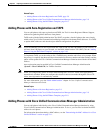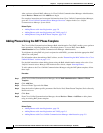
2-7
Cisco Unified IP Phone 6901 and 6911 Administration Guide for Cisco Unified Communications Manager 8.0 (SCCP)
OL-20852-01
Chapter 2 Preparing to Install the Cisco Unified IP Phone on Your Network
Adding Phones to the Cisco Unified Communications Manager Database
Adding Phones to the Cisco Unified Communications Manager
Database
Before installing the Cisco Unified IP phone, you must choose a method for adding phones to the
Cisco Unified Communications Manager database. Be aware that each phone type requires a fixed
number of device license units and the number of unit licenses that are available on the server may
impact phone registration. For more information on licensing go to the Licenses for Phones section in
the Cisco Unified Communications Manager System Guide
These sections describe the methods:
• Adding Phones with Auto-Registration, page 2-8
• Adding Phones with Auto-Registration and TAPS, page 2-9
• Adding Phones with Cisco Unified Communications Manager Administration, page 2-9
• Adding Phones Using the BAT Phone Template, page 2-10
5. Accessing a TFTP Server
In addition to assigning an IP address, the DHCP server directs the
Cisco Unified IP Phone to a TFTP Server. If the phone has a statically
defined IP address, you must configure the TFTP server locally on the
phone; the phone then contacts the TFTP server directly.
Note You can also assign an alternative TFTP server to use instead of the
one assigned by DHCP.
• Configuring Settings on the
Cisco Unified IP Phone,
page 4-1.
• Resolving Startup Problems,
page 7-1.
6. Requesting the Configuration File
The TFTP server has configuration files, which define parameters for
connecting to Cisco Unified Communications Manager and other
information for the phone.
• Adding Phones to the Cisco
Unified Communications
Manager Database, page 2-7.
• Resolving Startup Problems,
page 7-1.
7. Contacting Cisco Unified Communications Manager
The configuration file defines how the Cisco Unified IP Phone
communicates with Cisco Unified Communications Manager and provides
a phone with its load ID. After obtaining the file from the TFTP server, the
phone attempts to make a connection to the highest priority Cisco
Unified Communications Manager on the list.
If the phone was manually added to the database, Cisco
Unified Communications Manager identifies the phone. If the phone was not
manually added to the database and auto-registration is enabled in Cisco
Unified Communications Manager, the phone attempts to auto-register itself
in the Cisco Unified Communications Manager database.
Resolving Startup Problems,
page 7-1.
Table 2-3 Cisco Unified IP Phone Startup Process (continued)
Task Purpose Related Topics




